Chrysocolla
Gemstone Quality Standard
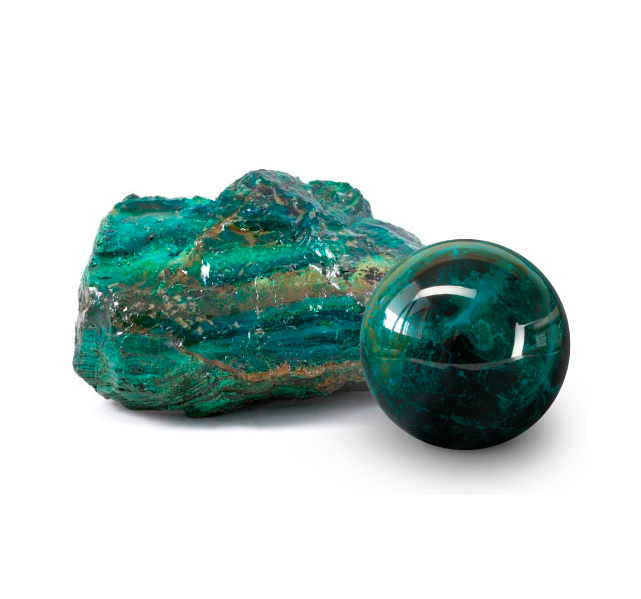
About Chrysocolla
Chrysocolla is one of the Peruvian flagship minerals for jewelry and decor products. It is a minor ore of copper that forms in the superficial oxidation zones of copper ore bodies. Chrysocolla is mined in the southern Peruvian desert and on the western slopes of the Andes where artisan miners search for the greenish coloration in the desert sand indicating the presence of chrysocolla.
When mining into the depth and following the chrysocolla veins miners might then eventually find copper bodies.
Chrysocolla itself has a cyan (blue-green) color. However, Chrysocolla veins are in fact never made of pure chrysocolla but rather consist of a mixture of this mineral with a number of others. We find it mixed mostly with:
- Cuprite – an oxide mineral composed of copper oxide Cu2O, and is a minor ore of copper. It is dark red to cochineal red, sometimes almost black.
- Malachite – a green copper carbonate hydroxide mineral.
- Tenorite – dull grey-black.
- Quartz – The white milk quartz or milky quartz is the most common variety of crystalline quartz.
- Lemonite – yellow
- Azurite – a soft, deep-blue copper mineral
Even if a material is called “Chrysocolla”, most likely the real Chrysocolla mineral itself only makes up for a small percentage within the mix of minerals.
Generally spoken: The higher the concentration of real Chrysocolla in the mixed vein (means the more uniform cyan its color) the more costly is the rough rock. Pure cyan-coloured chrysocolla pieces are generally used for jewelry only because they are small and very expensive.
Also, the more chrysocolla is in the mix, the harder it is to cut as the chrysocolla itself is very soft and easily breaks and chips.


Rarity
Chrysocolla is often thought to be very common and not rare. While it is correct that chrysocolla itself is commonly found on top of copper reserves, from a jewelry point of view its not about finding any type of Chrysocolla, it is about finding a beautiful one.
“Beauty” is determined by the type of mineral mix (with chrysocolla just being one of several minerals in each mix). The mix of minerals (and therefore the coloration) varies from vein to vein and even within the same vein it changes with increasing depth of the vein. The veins are so characteristic in their coloration that an experienced Peruvian gem cutter can identify the mine by looking at a polished Chrysocolla product on the internet.
Not all chrysocolla veins qualify for jewelry (in fact most do not). Additionally, the size of a vein can never be foreseen. Some Chrysocolla veins may last a few years and put out hundreds of tons of chrysocolla mix. Others may end after a few months.
Finally, even if a vein is good for jewelry, only a small part of the material within the vein qualifies for top-quality jewelry. Finding pure chrysocolla big enough to cut a cabochon is probably the rarest event of all.
Taking all this into account, Jewelry-grade Chrysocolla is actually very rare, at least if one looks for a certain color combination.
Availability
All of the following Chrysocolla mixes are only available in the smallest amounts that have been saved by us for use in jewelry. We do not sell the rough rock. We offer custom cutting of this material for jewelers and sell finished cabochons as well as our own jewelry with cabochons made from this material.
You can buy our finished top-quality cabochons for jewelry makers.
National and international shipping from our US-based warehouse.


Peruvian Chrysocolla Mixes
Each of the following mixes comes from a different mine. Many of the Chrysocolla mixes listed on this page are exclusive materials from Gemrock, because it is historic material that was saved up by us for jewelry production and the mines are no longer operating, with the veins being fully extracted. Therefore, most of these color combinations can only be obtained from Gemrock.


Pure Chrysocolla (AAA)
Cyan-colored Chrysocolla. Very small amounts of green (Malachite) may be allowed.

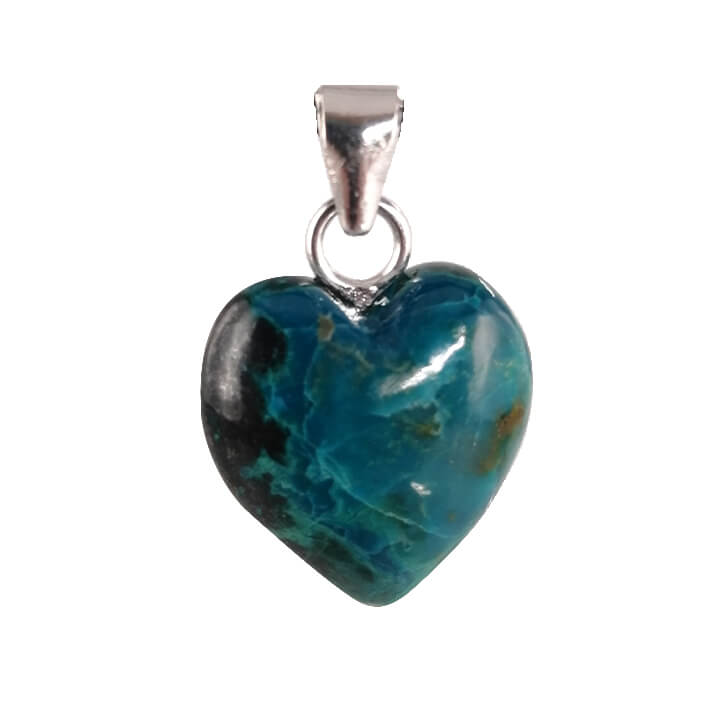
Classic Chrysocolla (AA)
This mix of Chrysocolla with Malachite (green) and Tenorite) comes from the most famous Chrysocolla Mine in Peru and has made Peruvian Chrysocolla famous. As production has greatly diminished the price of raw material has increased at least 1200% over the course of the last 6 years.

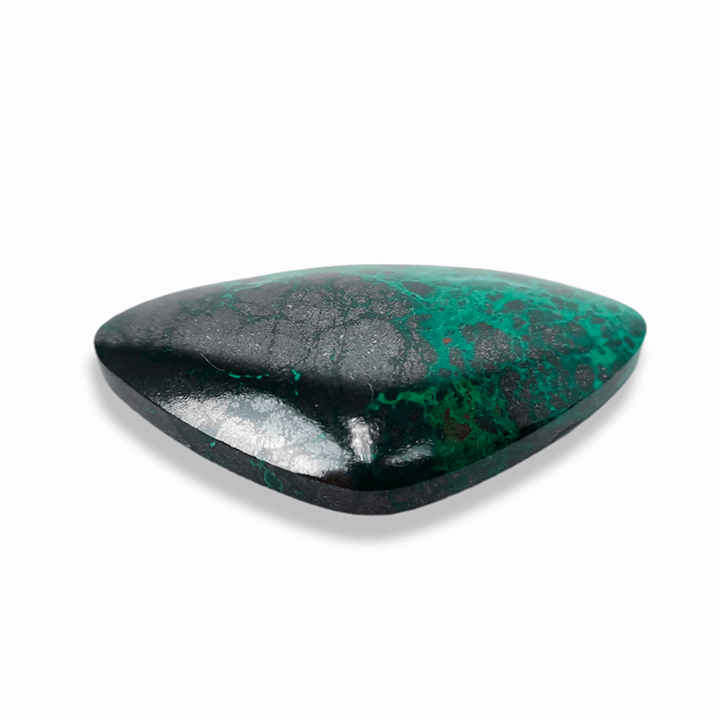
Classic Chrysocolla (lower grade) (A)
A mix of Malachite and Tenorite with very little Chrysocolla. Still, a beautiful coloration for impressive cabs.


“Water and Wine”
Super blue Chrysocolla (=water) in dark reddish matrix (=Wine)


Turquoise Chrysocolla
This is NOT Turquoise. It is a Chrysocolla with a color very similar to turquoise. This Chrysocolla vein produces a material that can not be used for jewelry. The high lime content in this material makes it impossible to polish. We own approximately 50 kilos of Tourquoise Chrysocolla that have been sorted out by hand from a total of 10 tons (10,000 kilos) of rough rock. This tiny amount (0.5%) has a consistency with very little lime that allows for using it for jewelry.

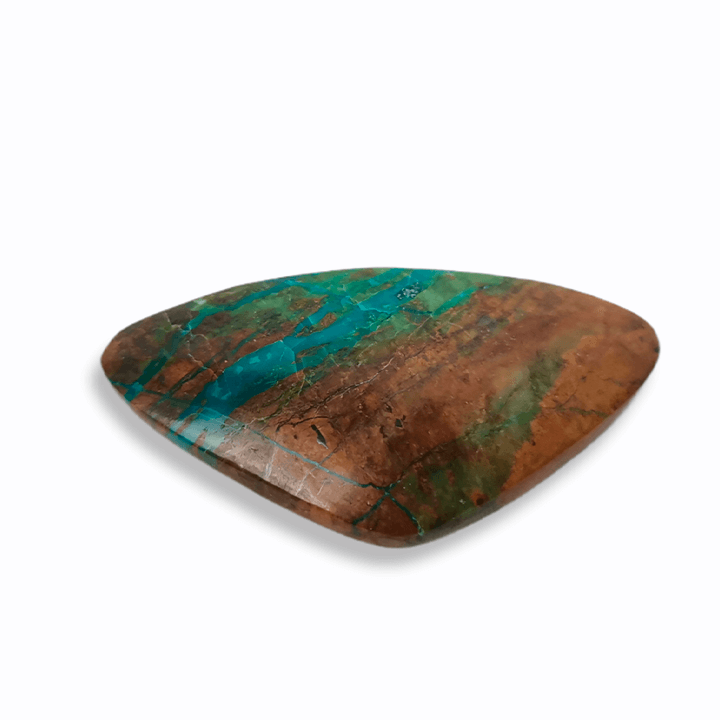
“Mother Earth”
Tiny superblue Chrysocolla veins within brown and green (=Malachite) matrix. When cut it looks like a desert landscape with rivers and lakes, seen from a bird perspective.


“Il Fresco”
A very strange Chrysocolla mix in a whitish or dark brown matrix. Especially the whitish version remembers the fractured coloring of an old Roman fresco, which inspired the name of this coloration.
You can buy our finished top-quality cabochons for jewelry makers.
National and international shipping from our US-based warehouse.


Chrysocolla from other countries

Chrysocolla from Congo
Chrysocolla in layered Malachite. The layered malachite may also form circles. Easy to recognize. Originates from Congo. If you want ethical crystals you may reconsider buying this material given the human rights violations in the mining industry in Congo.
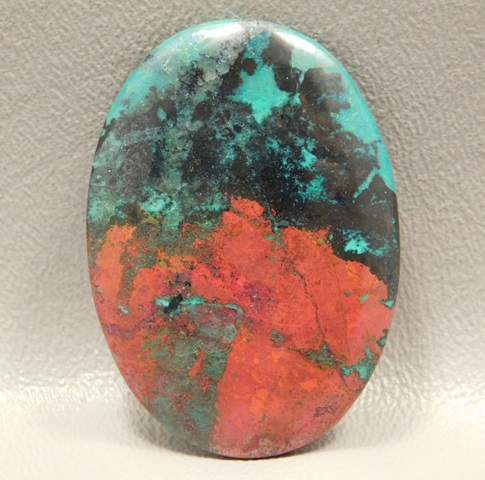
Sonora Sunset
Cabochons sold under the marketing name Sonora Sunset come from the Sonora desert and are easy to recognize. They consist of Chrysocolla, red Cuprite and iron.

Parrotwing
A mix of Chrysocolla with Tenorite, Cuprite, and other minerals – a very colorful material. Originally Parrot Wing Chrysocolla came from Mexico only. Nowadays everyone uses the marketing name for any kind of colorful Chrysocolla mix with other minerals.

Arizona Chrysocolla
Chrysocolla from Arizona


Cutting Quality
Challenges:
In Gemrock we are used to telling our new gem cutters: “If you can cut pure Chrysocolla, you can cut any stone.” With an MOH scale hardness of only 3.5, pure Chrysocolla is probably the most brittle gemstone globally, and cutting it is any gem cutter’s nightmare. It can break and crumble in any of the production steps from cutting the slab to the finishing polish at 6000 grit. We estimate that probably 90 percent of pure chrysocolla cabochons break at any point in the production. Therefore, pure chrysocolla cabs are very expensive.
Gem cutters generally prefer Chrysocolla mixes, where the other materials in the mix provide strength to the cabochon. However, even if mixed with other minerals Chrysocolla cab production still suffers a much higher rate of breakage than other gemstone materials. This is important to consider when discussing fair pricing.
Top-cutting-quality is characterized by:
- a polished backside
- a sharp unchipped edge between the backside and the bezel
- a very straight and even highly polished bezel
- a sharp unchipped edge between the bezel and the dome
- a well-shaped dome, not showing any deformation
- Top-quality polish



Pricing
Adequate pricing must take into account the cost factors to obtain top-quality cabochons:
- Acquisition of top-grade Angelite with strong color in the mine.
- Selection of material without impurities and discarding more than 80 percent of the rough rock as unsuitable for jewelry.
- A usual material loss of approximately 90 % of the selected material during the cutting and shaping process.
- The level of experience required by a cutter to produce a flawlessly shaped and highly polished cabochon from such a soft material.
You can buy our finished top-quality cabochons for jewelry makers.
National and international shipping from our US-based warehouse.
- Market research
- Our Jewelry Grade (A)
- Our Top-Quality Jewelry Grade (AA)
- Our Premium Jewelry Grade (AAA)
The data in this sheet has been compiled by reviewing a great number of websites and sales platforms.
Material quality:
Cutting quality:
Quality Grading
Pricing
Jewelry Grade Material:
Boulder Chrysocolla: Matrix material with small spots of chrysocolla
Boulder Chrysocolla (Mother Earth): Brown and green matrix material with fine veins of pure chrysocolla.
Water and Wine Chrysocolla: Dark red matrix material with chrysocolla spots
Turquoise Chrysocolla: Turquoise-colored Chrysocolla with blackish/reddish spots
Classic Chrysocolla: blackish Tenorite with green Malachite and turquoise colored Chrysocolla
Cutting Quality:
- Straight bezel (minor irregularities possible), 3 mm high
- Perfect dome (3-5 mm high)
- Edges between bezel and dome, as well as bezel and backside: sharp and crispy, minor chips on lower edge possible
- Backside flat at 280 grit, unpolished
Pricing:
Recommended Retail Price:
Boulder Chrysocolla: 1.5 USD per carat
Boulder Chrysocolla (Mother Earth): 1.5 USD per carat
Water and Wine Chrysocolla: 1.5 USD per carat
Turquoise Chrysocolla: 1.5 USD per carat
Classic Chrysocolla (A): 2 USD per carat
Jewelry Grade Material:
Classic Chrysocolla (AA): Green malachite with lots of turquoise-colored Chrysocolla and very little blackish Tenorite
L´affresco Chrysocolla: white or dark brown matrix with fine chrysocolla lines and spots
Cutting Quality:
- Straight bezel, 3 mm high
- Flat and perfect dome (3 mm high)
- Edges between bezel and dome, as well as bezel and backside: sharp and crispy, minor chips on lower edge possible but very rare.
- Backside flat, at 280 grit
Pricing:
Recommended Retail Price:
Classic Chrysocolla (AA): 4 USD per carat
L´affresco Chrysocolla: 2 USD per carat
Jewelry Grade Color:
Pure Chrysocolla (AAA): nearly 100% chrysocolla, tiny amounts of green malachite allowed
Cutting Quality:
- Straight bezel, 3 mm high
- Flat and perfect dome (1-3 mm high)
- Edges between bezel and dome, as well as bezel and backside: sharp and crispy, no chips on lower edge.
- Backside flat, polished to 3000 grit
Pricing:
Recommended Retail Price:
Pure Chrysocolla (AAA): 10 USD per carat

For Charms & Pendants
Ethical Silver Accessories
for Jewelry Makers
Hundreds of charms, pendants & chains
in
950 Silver, Sterling Silver, tarnish-resistant Moonlight Sterling Silver, gold-plated silver and gold.
Guaranteed Free of toxic alloys.
How to avoid fake & toxic silver:

For Chains
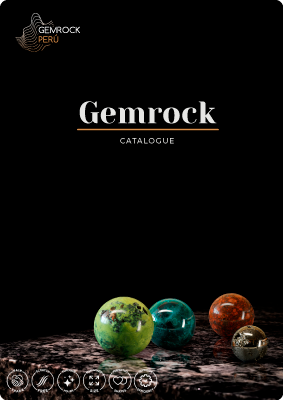
Cutting services
Do you need reliable high-quality cutting services for a reasonable price? Are you looking for a service provider that is willing to develop new products according to your requirements? Would you like to get expert advice in order to improve your product? Do you wish for someone to optimize the process and get the most out of your rough? Just talk to us.
Free Gemrock Learning Resources
Free Gemrock Learning Resources
Connect wherever you want and can
Connect wherever you want and can
Get in Touch
+51 994104206
gemrockinternational@gmail.com











